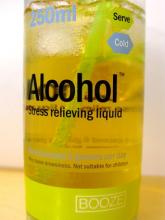If you are a drinker, you are a recreational drug user. This is an idea most drinking cultures have never been able to accept in a healthy way. Those few times in history when alcohol has been treated as an illicit substance, it has been demonized and subjected to damaging myth in lieu of scientific fact. This mostly has to do with the difficulty of forming a culture-wide perception of intoxicating substances that is mature and realistic. We feel the need to classify mind-altering substances in a variety of semantic categories so some can get away with altering minds without being perceived as "evil" or deadly. The danger of classifying alcohol as what it truly is, a psychoactive substance that people consume for the express purpose of enjoying intoxication, is that doing so forces us to approach all psychoactive substances with the same nonchalance with which we approach alcohol.
Herein lies the complexity of the situation. We are a bit too nonchalant about alcohol precisely because it is a drug. We soften the idea of intoxication by labeling it "drunk" instead of "high" or "stoned", even though there is no functional difference between those ideas. We turn the oral consumption of the drug ethanol into a food experience by referring to discreet amounts of it as "drinks" and not "doses", even though one "drink" of whiskey is considerably less in total liquid volume than one "drink" of beer. All culture and stigma removed, the difference between beer, wine and whiskey is functionally identical to the difference between Vicodin, Vicodin ES and Vicodin HP (5 mg, 7.5 mg and 10 mg of hydrocodone, respectively). As with any other drug, the effects of alcohol can intensify or change, as well as the prevalence and intensity of side effects, depending on the dosage of the active substance and the accompanying contents of other substances, such as water, sugar and caffeine.
Ah, but we can't really treat alcohol like a drug because in our culture, many drugs are tightly controlled. We need prescriptions from doctors for specific substances, we need to visit pharmacies and fill out forms, we need special permission to get refills and we're given detailed instructions about proper use. Even though the duration and intensity of the high produced by five fluid ounces of ethanol is comparable to the high produced by 15 mg of hydrocodone, the former is vended in grocery stores to anyone over the age of 21 in possession of a valid ID while the latter is vended in pharmacies behind several layers of security to only those in possession of a valid prescription.
The real difficulty of promoting this argument is that neither the ease of acquiring alcohol nor the inconvenience of acquiring other, equally dangerous, intoxicating substances are a truly superior social model. The difference between alcohol, prescription medication and even illegal substances is that society has learned to deal with the ubiquity of alcohol and the stoned people it creates. All drinking cultures have long been acclimatized to the presence of those under the influence of a particular drug, so much so that few people even think of alcohol as a drug. It'll be a long time before society at large comes to accept the presence of the ever-expanding variety of drugs flowing through the collective system, legally or otherwise, so it remains the responsibility of the individual to be honest about what alcohol truly is. It's a recreational drug, a medication with a number of applications that is available in various doses and methods of delivery. It's not food, it's not evil and it's not more or less dangerous than any other drug.
